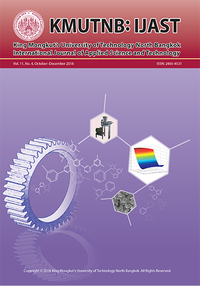Dynamic Characteristics of Amorphous Photovoltaic Module by Light-induced Degradation
Main Article Content
Abstract
This paper is a study on the impacts of dynamic characteristics on the light-induced degradation phenomena, the modules under test were amorphous tandem (a-Si:H/a-Si:H). There dynamic characteristics of amorphous thin film silicon Photovoltaic module (PV module) by dynamic impedance technique. The I-V characteristics of Photovoltaic (PV) modules are generally measured at Standard Test Condition (STC) or in the dark. It's unable to explain the phenomena in the light-induced degradation in terms of material properties. Dynamic characteristics cannot be revealed by I-V curves measurements. Dynamic impedance were measured and analyzed by using the basic instrument. From the experimental results, it is found that dangling bonds and localized states phenomena resulting from light-induced degradation can obviously be reflected on dynamic parameter with forward biasing. In this paper show the PV module is stable stage about 148 kWh/m2 or a month, The series resistance (RS) is increased, shunt resistance (Rsh) and internal diode dynamic resistance (Rd(V)) are decreased continuously, Similarly, the diffusion capacitance (CD(V,ω)) were slightly decreased after light-induced by outdoor exposure. The decays observed can be proposed that there states localized of band tails are due to minority carrier lifetime an outside the transition region. It is proportional to the current of electricity, It is according to the Maximum current (Im) and Maximum power (Pm) is decreasing by light-induced degradation.
Article Details
References
[2] Y. Hamakawa, Amorphous Semiconductor Technology & Devices. Netherlands: North-Holland Publishing Co., 1982, pp. 33–199.
[3] R. F. Pierret, Semiconductor Device Fundamentals. Boston, Massachusetts: Addison-Wesley Publishing Company, Inc., 1996, pp. 23–344.
[4] B. Pivaca, I. Kovacevica, and I. Zulim, “Defects induced in amorphous silicon thin films by light soaking,” Thin Solid Films, vol. 403–404, pp. 513–516, 2002.
[5] G. Nobile and M. Morana, “Light soaking effect in a-Si:H based n-i-p and p-i-n solar cell,” Solar Energy Materials and Solar Cells, vol. 76, pp. 511–520, 2003.
[6] The International Electrotechnical Commission (IEC), Thin-Film Terrestrial Photovoltaic (PV) Modules - Design qualification and type approval, 2nd ed., Switzerland: IEC publications, 2008, pp. 21–22.
[7] R. Ani Kumar, M. S. Suresh, and J. Nagaraju, “Effect of solar array capacitance on the performance of switching shunt voltage regulator,” IEEE Transection Power Electrics, vol. 21, no. 2, pp. 543–548, 2006.
[8] D. Chenvidhya, K. Kirtikara, and C. Jivacate, “PV module dynamic impedance and its voltage and frequency dependencies,” Solar Energy Materials and Solar Cells, vol. 86, pp. 243–251, 2005.
[9] N. Silsirivanich, D. Chenvidhya, K. Kirtikara, K. Sriprapha, J. Sritharathikhun, R. Songprakorp, and C. Jivacate, “Non stationary effects at photovoltaic module characterization using pulsed solar simulator,” Journal of Apply Spectroscopy, vol. 82, no. 2, pp. 293–292, 2015.


